First quarter
fishery production in Eastern Visayas drops by 29.0%
By
PSA-8
May 25, 2018
TACLOBAN CITY –
Fishery production in Eastern Visayas dropped by 29.0% from 37,607
metric tons (MT) in the first quarter of 2017 to 26,704 MT in the
first quarter of 2018.
All provinces registered
decreases in fishery production, except Samar, the only province
that recorded a significant increase of 24.5%, from 9,498 MT in the
first quarter of 2017 to 11,822 MT in the same quarter in 2018.
Leyte recorded the highest decrease of 68.4%, from 17,517 MT in the
first quarter of 2017 to 5,527 MT during the quarter in review.
Among provinces, Samar
produced the highest volume of fishery production at 11,822 MT,
which comprised 44.3% of the total fishery production in the region.
Leyte ranked second with 5,527 MT, which accounted for 20.7% of the
region’s total fishery production. Southern Leyte, meanwhile
registered the lowest volume of production with 4.7% share or 1,249
MT.
By subsector, volume of
production in Aquaculture went down by 49.4%, from 16,291 MT in the
first quarter of 2017 to 8,244 MT in the same period in 2018. All
provinces registered decreases, except Samar, the only province that
recorded an increase of 124.2%. Biliran recorded the highest
decrease of 100.0 percent, from 5 MT in the first quarter of 2017 to
zero during the quarter in review.
Similarly, volume of
production in Municipal Fishing (marine and inland) registered a
decrease of 16.4%, from 17,682 MT in the first quarter of 2017 to
14,776 MT in the same quarter in 2018. All provinces registered
decreases, except Southern Leyte, the only province which posted an
increase of 4.2%. Leyte registered the highest decrease in volume of
production at 27.2%.
On the other hand, volume
of production in Commercial Fishing increased by 1.4%, from 3,634 MT
in the first quarter of 2017 to 3,684 MT in the same period in 2018.
Among provinces, only Samar registered growth in production of
68.9%. This increase offset the decreases recorded by Biliran
(44.3%), Eastern Samar (0.3%), Leyte (39.0%), Northern Samar (10.2%)
and Southern Leyte (45.3%).
More than half or 55.3%
(14,776 MT) of the total fishery production in the region were from
Municipal Fishing. Aquaculture contributed 30.9% (8,244 MT), while
Commercial Fishing accounted for 13.8% (3,684 MT).
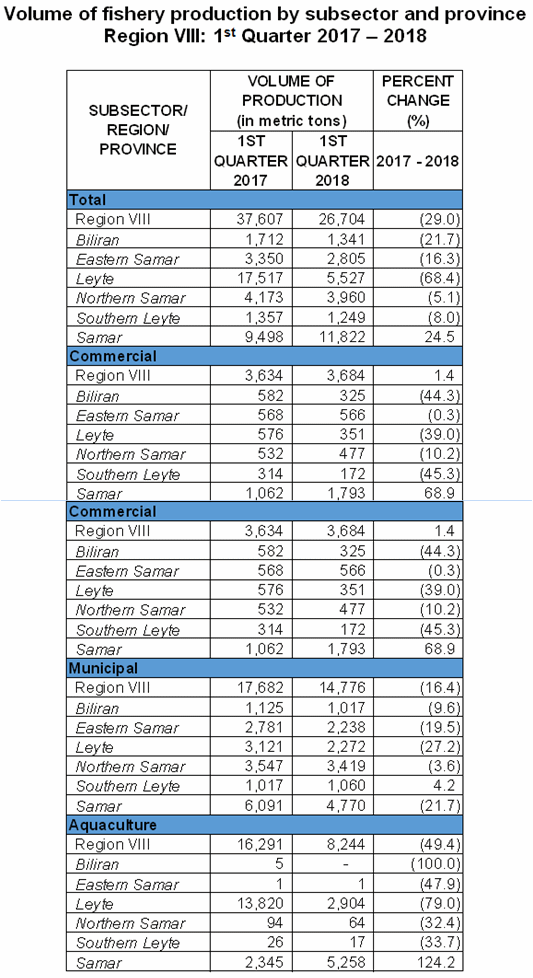
People’s group, energy insti,
Atimonan community:
EO 30 to expedite
‘irregularity-ridden’ Atimonan coal project
Press Release
May 25, 2018
QUEZON CITY –
Energy groups and Atimonan community members scored Department of
Energy (DOE) Secretary Alfonso Cusi for considering Atimonan One
Energy, Inc.’s (A1E) “irregularity-ridden” Atimonan coal power plant
as one of the first energy projects to be classified as an Energy
Project of National Significance (EPNS) under Executive Order 30 (EO
30).
“Secretary Cusi’s positive
consideration of the Atimonan coal power plant project as an EPNS is
a huge blow to the Atimonan community – especially to Atimonan
fisherfolk and farmers,” said Atimonan fisherfolk member Joseph
Benedict.
“Atimonan residents have
suffered deception and harassment, on top of loss of livelihood and
health, in the push for the hasty and irregular approval and
construction of its coal plant project in Atimonan,” said Benedict.
“The Atimonan community,
together with civil society organizations, have been putting up a
long fight against this coal project – their impending
classification as EPNS tells us the government is not on our side
here,” said Benedict.
Under EO 30, permit
applications of EPNS-classified projects shall be acted upon by
concerned government agencies not exceeding a 30-day period;
otherwise, said permit applications are automatically deemed
approved.
Sanlakas Secretary-General
Atty. Aaron Pedrosa expressed alarm that this mechanism now appears
to be a tool for prioritizing and legitimizing “dubious and
destructive” energy projects like the proposed Atimonan power plant,
a project with a long record of violating processes established to
protect the interests of electricity consumers and host communities.
Pedrosa cites Meralco,
through its power generation arm Meralco PowerGen Corp. (MGen) that
wholly owns the Atimonan One Energy (A1E), as a ‘habitual violator’
of procedures and human and ecological rights.
Atimonan fisherfolk member
Joseph Benedict recounted instances of irregularities in the
procurement of community consent to the project.
“On 2012, Atimonan
community members, including fisherfolk, were made to be on board
the Atimonan project because it postured as a Liquefied Natural Gas
project. On 2014, however, the project turned out to be of coal
plants instead. However, no new public scoping was made in response
to this new project, and the conducted public hearing had suppressed
opposing community members, like my fellow fisherfolk, from voicing
out our resistance,” said Benedict.
Benedict stated that this
kind of suppression of opposition from communities is on top of
instances of harassment and land grabbing made against fisherfolk
and coconut farmers alike.
According to Sanlakas
Secretary-General Atty. Aaron Pedrosa, this irregular conduct of
procuring local consent violates Sections 26 and 27 Local Government
Code, provisions which require a meaningful consultation with local
government units, nongovernmental organizations, and other sectors
concerned as regards any project.
Pedrosa also stated that
aside from irregularities in the process for local consultation with
the people of Atimonan, MGen’s coal project has also been involved
in violating the process for submission of Power Supply Agreements (PSAs)
in the Energy Regulatory Commission (ERC), a process which seeks to
ensure that electricity consumers are given the cheapest, most
competitive source of electricity.
“MGen, along with other
Meralco-affiliated coal companies, have been the subject of cases
filed in the Ombudsman for their alleged collusion with officials
from the ERC,” said Pedrosa.
“Clearly, MGen has formed
a habit of gross disregard for law and for community welfare,” he
added.
Energy research
institution Center for Energy, Ecology, and Development (CEED)
claimed that the consideration of the Atimonan project as one of the
first possible EPNS highlights how EO30 can be utilised to advance a
fossil fuel-dependent energy development path for the next 20-25
years in under 30 days.
“Globally, the trend is
towards retiring existing coal-fired power plants, whether HELE or
not, and to stop further implementation of coal projects. Coal
projects are increasingly becoming obsolete and economically
unviable,” said CEED Legal and Policy Officer Atty. Avril De Torres.
De Torres cited studies by
energy economics institutes which emphasized findings on governments
worldwide that have been adopting policies of pricing coal projects
according to surfaced environmental, health, and economic costs of
constructing and maintaining coal projects.
According to De Torres,
these resulting changes in the global energy market put coal
projects at the risk of being stranded assets and it is the public
at large that will be paying for an economically unviable coal
project.
“The classification of
coal plant projects as an EPNS goes against existing policies, laws
and global trends that favor renewable energy projects over fossil
fuels,” said De Torres.
“It’s frightening to think
that because a coal project can be considered as EPNS, it can be
decided in less than a month to be our source of energy for the next
decades,” she concluded.
|
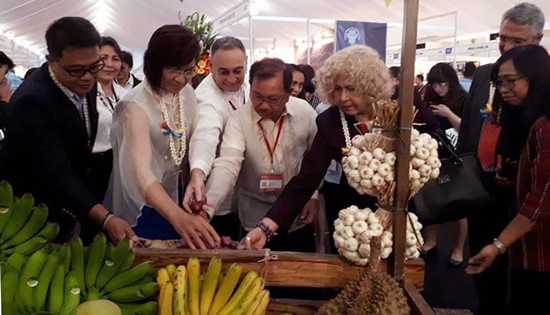
From
L-R: DTI Undersecretary Rowel Barba, DTI Undersecretary Nora
K. Terrado, Food and Agriculture Organization Representative
Jose Luis Fernandez, DA Secretary Emmanuel Pinol and
Venezuelan Ambassador to the Philippines Capaya Rodríguez
González. |
DTI supports
coastal communities through int’l food expo
By
DTI-TIPG-EMB
May 25, 2018
MAKATI CITY – The
Department of Trade and Industry through its Center for
International Trade Expositions and Missions (CITEM) featured the
‘best of the seas’ as it welcomed buyers for the 12th International
Food Exhibition Philippines (IFEX) 2018 on May 25 to May 27, 2018 at
the World Trade Center and Philippine Trade Training Center in Pasay
City.
“Marking its return as an
annual event, IFEX Philippines 2018 will highlight the country’s
finest seafood to fulfill the growing global demand for marine
product and coastal cuisines,” said DTI Trade and Investment
Promotion Group Undersecretary and CITEM Officer-in-Charge Nora K.
Terrado.
Participated in by over
450 Philippine micro, small, and medium-sized enterprises (MSMEs)
including those from coastal communities from Northern Luzon and
Mindanao, the trade show is composed of four major exhibition halls:
Food Philippines Hall, International Hall, Food Artisans Hall, and
the Marketplace.
“This is also our way of
supporting the promotion of agribusiness sector in the country that
provides employment opportunities especially in the regions,” added
Terrado.
Among the municipalities
joining the said trade show is the General Santos City, the Tuna
Capital of the Philippines. Local companies will showcase their
world‐class tuna varieties, including skipjack, yellowfin, bluefin,
and bigeye tuna, in different packaging options during the three-day
show.
“General Santos City is
home to one of the world’s best‐tasting tuna catches available to
the international and local market and we wanted to highlight this
as we position the Philippines as a go‐to sourcing destination for
high‐quality tuna and tuna‐like species,” said Terrado.
As of 2016, the city’s
tuna industry generates 65 percent of the country's over-all tuna
catch and employs around 200,000 workers.
According to Southeast
Asian Fisheries Development Center (SEAFDEC), the Philippines is top
three tuna producer in the world in terms of volume. Eighty (80)
percent of Philippines seafood is exported to the United States and
the European Union, with a value of approximately US $120 million
export earnings per year.
“The Philippines is also
currently ranked as the second largest manufacturer of canned and
processed tuna in Asia, after Thailand, with a majority of this
catch landed in the port of General Santos City,” said Terrado.
SEAFDEC data also showed
that tuna is the Philippines’ top export fish commodity valued at
P19.6 billion pesos in 2014, making up 35 percent of the country’s
total fishery export.
IFEX Philippines 2018 is
the country’s biggest international trade exhibition on the
Philippines’ and Asia's ethnic and specialty food, tropical fruits,
vegetables, seafood, beverages, bakery and confectionery products,
meat and poultry, Halal-certified products, as well as natural,
organic, and healthy food products.
To streamline export
deals, DTI-CITEM opened its ‘IFEX Connect’ program, a customized
platform for integrated business-to-business (B2B) matching services
to help buyers identify and screen potential business partners among
the exhibitors, in collaboration with DTI’s Export Marketing Bureau
(EMB).
“We expect a more upbeat
exchange of trade deals, sealing of partnerships and knowledge
transfer through our B2B activities and learning seminars,” said
Terrado.
In its previous four
editions in 2011 to 2017, IFEX Philippines has already welcomed
nearly 6,600 international and local buyers across the world: 1,270
in 2011, 1,259 in 2013, 1,976 in 2015 and 2,092 in 2017 – increasing
at an average of 14 percent over the past four editions.
From 2009 to 2017, the top
10 countries where these buyers came from are the United States,
Japan, Singapore, China, United Arab Emirates, South Korea,
Malaysia, Australia, Taiwan and Canada, respectively.
The 12th edition of IFEX
is organized by the DTI-CITEM in close partnership with Department
of Agriculture (DA), through the Bureau of Fisheries and Aquatic
Resources (BFAR) and the Agribusiness and Marketing Assistance
Service (AMAS).
Government: No. 1
on list of violators of illegal contracting
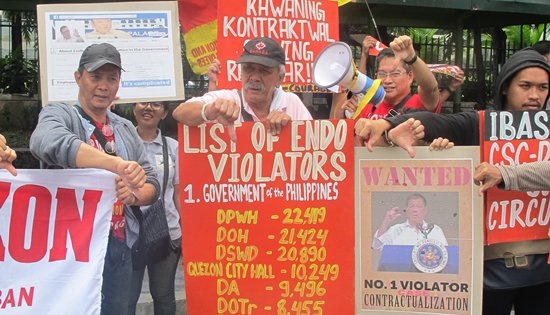
By
COURAGE
May 25, 2018
QUEZON CITY – If
there is an entity that should be in the list of violators of
illegal contracting or sub-contracting, then the first on the list
should be the Government of the Republic of the Philippines,
Ferdinand Gaite of COURAGE said.
In President Rodrigo
Duterte’s recent Labor Day speech, he ordered DOLE Secretary
Silvestre Bello to submit the list of violators of illegal
contracting or subcontracting with today as the deadline. This after
Duterte signed Executive Order No. 51 which was supposed to end
contactualization but instead only reiterated what was already in
the Labor Code or Herrera Law allowing “labor contracting”. Gaite
said that with the more than 720,000 non-regular workers called
casuals, contractuals, job orders, contract of service and others
out of the 2.3 million government employees, the government is the
largest violator and should be the first to be penalized. This
figure pales in comparison with other private companies such as
Jollibee, McDonalds, SM and others who have also violated the law
against illegal contracting.
According to the Inventory
of Government Human Resources of the Civil Service Commission as of
2016, the 720,000 non-regular employees can be found in various
government agencies with the Department of Public Works and Highways
(22,419), Department of Health (21,424), and the Department of
Social Work and Development (20,890) at the top three. Also at the
top are the Quezon City Local Government (10,249), Department of
Agriculture (9,496), Department of Transportation (8,455),
Department of Environment and Natural Resources (8,123) and the
Department of Education (6,602). Notable also is that 420,000 of the
non-regular workers mostly come from the 1,715 local government
units.
In a noontime picket at
the DA today, government employees demanded from the Duterte
administration for the immediate end of contractualization as he had
longtime promised. Roxanne Fernandez of the Kawani Laban sa
Kontraktwalisasyon (KALAKON) and a contractual employee from the
National Anti-Poverty Commission said that as non-regular workers,
they have no security of tenure, no social insurance protection, no
or minimal benefits, disallowed from joining unions, have relatively
lower pay but actually pay higher taxes as they are treated as
“individual contractors” or a business entity.
Fernandez also pushed for
the passage of House Bill 7415 authored by the Makabayan bloc in the
lower house which seeks to prohibit contractualization in
government, grant security of tenure and civil service eligibility
for all non-regular workers who have rendered at least 6 months of
government service. She said that this should be made a priority
bill and urged the lawmakers to immediately pass the bill. She said
that Duterte should expect more protests from the public and private
labor sector for his failed promises.
P70M Gandara-Matuguinao
Road portion completed

By
JASON T. DELOS ANGELES
May 24, 2018
CALBAYOG CITY – As part of the Build Build Build program of the
present administration, the Department of Public Works and Highways
-Samar First District Engineering Office completes the construction
of the 2-kilometer road portion connecting Gandara and Matuguinao.
This project is beneficial to more or less 34,000 residents of the
municipalities of Gandara and Matuguinao. It provides easier, safer
and smoother access from Gandara to Matuguinao since the road gets
muddy during rainy seasons.
“The long-time dream of our people to be connected to the growth
centers of Samar has finally come true. This concrete road has a
great impact to daily lives of the residents because they no longer
have to travel in the muddy road, now they can easily transport the
agricultural products in a convenient way,” said Inan Torres, a
resident of the village of Pizarro in Matuguinao.
This project portion has an appropriation of P70 million and is
under contract with B. Vicencio Construction. It was completed on
February 18, 2018.
DPWH completes
P50-M flood control in Calbayog
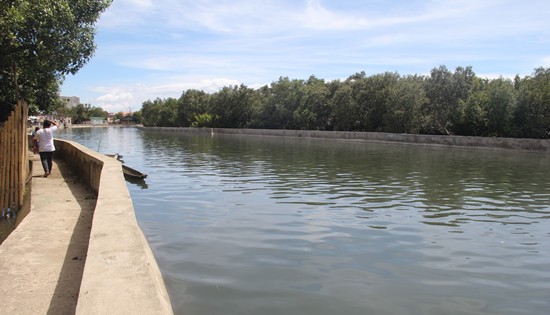
By
ELENOR A. ANOLLADO
May 24, 2018
CALBAYOG CITY – The
Department of Public Works and Highways (DPWH) -Samar First District
Engineering Office (SFDEO) completes the construction of flood
control structures along Calbayog River (upstream) in Brgy.
Hamorawon.
The project covers the
construction of 336.57 meters of reinforced concrete river
protection works on steel sheet piles foundation. It is under
contract with B. Vicencio Construction with an appropriation of P50
million sourced out from the 2017 General Appropriations Act. It was
completed on October 13, 2017.
The flood control
structure mitigates the flooding caused by heavy rains and high
tides, benefitting the people of Brgys. Hamorawon, Payahan, Dagum
and adjacent barangays specifically those residing along the
Calbayog River.
“Ever since this flood
control project was completed, the river no longer overflows. We are
so happy for this project because there are no more floods. We are
so happy because before, we used boats to go to school and work but
with this project, we now use the pathways provided by the flood
control structure. It really has been a big help to our community,”
said PO1 Jessica Amor, a local residing near the river.
PH to develop
AI-enabled workforce to address the threat of AI
By
DTI- OSEC-PRU
May 24, 2018
MANILA – The
Department of Trade and Industry (DTI) together with the Department
of Information and Communications Technology (DICT) and tech pioneer
company AI Pros, are set to join forces to train Filipinos in using
Augmented Intelligence (AI2) as a solution to the impending threat
of artificial intelligence on the jobs in the Information Technology
- Business Process Outsourcing (IT-BPO) industry, while encouraging
investors and operators to create more Socially Responsible Business
Process Outsourcing (SRBPO) in the countryside.
“Instead of AI replacing
jobs in the IT-BPO industry which is estimated to affect half of the
1.3 million jobs in the sector, the workers will be trained and
upskilled to make use of AI2-enabled systems. Basically, it’s making
the AI system become the solution to the problem,” Trade and
Industry Secretary Ramon Lopez explained.
“Augmented Intelligence
will combine the power of artificial intelligence with human
intelligence to upskill the Filipino workforce and make them more
effective and productive by enabling them to do complex and
higher-paying tasks. This initiative, summed up under the
“Philippine AI Workforce” brand campaign, will provide more jobs to
Filipinos and bring the development to rural communities,” DICT
Acting Secretary Eliseo Rio added.
“We are the first country
to launch this kind of initiative. Instead of looking at AI as a
threat to the BPO industry, the Duterte administration is using AI2
to provide more opportunities for inclusive growth. We will train
and enable our workforce, regardless of their background and
experience, to use AI2 to perform smarter and complete difficult
tasks, and help them move up the value chain. The training will make
them employable, operating even in the rural areas to make this
program truly inclusive,” said Sec. Lopez.
DTI and DICT will
introduce the presence of AI2 solution to the BPO sector in the
Philippines (PH). The AI2 solution will employ impact sourcing by
involving the masses in the sector’s growth. This will allow 482,000
unskilled workers to handle low-skilled work, while 525,000
low-skilled workers will perform mid-skilled work, and 309,000
mid-skilled workers will be able to do high level tasks.
“The entire industry
market is worth USD 262 billion and only USD 79 billion is
outsourced. With the government’s initiative and push for
innovation, we will be able to benefit from this market to open up
more job opportunities for the Filipinos which is the priority of
President Duterte,” said Sec. Lopez
“The idea here is to
empower not only the existing BPO workers but also involve those at
the rural areas. A pedicab driver or palengke vendor can be trained
in using AI2 and start to perform even high-skilled jobs in IT-BPM,”
the trade chief added.
With the help of AI Pros,
a technology company founded by Diosdado Banatao and George Yang,
industry operators will be assisted in expanding their businesses by
designing, developing, and deploying AI2-based services that can be
applied to retail, finance, services, and healthcare. Both Dr.
Banatao and Dr. Yang are successful Filipino entrepreneurs in
Silicon Valley who are committed to help the Filipinos level-up
their skills in the age of technology.
To encourage IT-BPO
operators to use an inclusive business model, expand their
businesses to provinces and become Socially Responsible BPO, DTI
through the Board of Investments (BOI) has this activity in the BOI
Investment Priorities Plan, entitled to incentives.
The Department will then
focus on promoting areas with high poverty rates to these companies
and provide rural residents with 654,000 jobs.
“Operating in rural
communities with high poverty rate will give BPO companies an
opportunity to lower their labor cost while providing meaningful
employment,” said DTI Assistant Secretary Rafaelita Aldaba.
“As we deepen our
participation and upgrade along the global value chains of
multinational companies, investments in AI activities in various
sectors of the economy will be supported,” said Sec. Lopez while
highlighting the inclusion of IT-BPM in the top industry priorities
to drive the country’s growth and development under the Inclusive
Innovation Industrial Strategy (i3S).
Meanwhile, DICT will
supply a fast and inexpensive internet connection for the BPO
operators located in the countryside. DICT’s 4,000 Tech4Ed centers
nationwide will also be utilized to assist recruitment and AI
training.
According to Sec. Rio, the
government will focus on rebranding and promoting the new
“Philippine AI Workforce” to support the BPO industry and improve
the country’s competitiveness.
The BPO industry has been
a key driver of PH growth for 15 years, supporting various
industries such as banking, retail, property, and providing 18
million employment opportunities nationwide. In a 2017 report, 50%
of the BPO operations are starting to be automated.
First quarter
corn production in Eastern Visayas decreases by 9.6%
By
PSA-8
May 23, 2018
TACLOBAN CITY –
Corn production in Eastern Visayas decreased by 9.6% from 11,649
metric tons (MT) in the first quarter of 2017 to 10,528 MT in the
same quarter of 2018. Decreases were observed among all provinces,
except in Southern Leyte and Eastern Samar, which posted increases
of 7.0% and 3.8%, respectively.
Among the provinces, Leyte
produced the highest volume of corn at 7,101 MT, which comprised a
little over two-thirds (67.4%) of the total corn production in the
region. Biliran, meanwhile, had the lowest volume of production (118
MT) accounting for only 1.1%.
The total harvest area for
corn in the region likewise decreased by 7.1%, from 8,081 hectares
in the first quarter of 2017 to 7,507 hectares in the first quarter
of 2018. Contributing largely to this decrease is Northern Samar
with a drop of 30.1%.
Leyte recorded almost
three quarters or 74.3% (5,574 hectares) of the total corn area
harvested during the quarter in review, while Eastern Samar
contributed the least (70 hectares) accounting for only 0.9%.
Yield per hectare for corn
in the region remained at 1.4 metric tons per hectare.
Among the provinces,
Eastern Samar posted the highest yield per hectare during the
quarter in review at 2.0 MT per hectare. Biliran registered the
lowest yield per hectare at 1.2 MT per hectare.
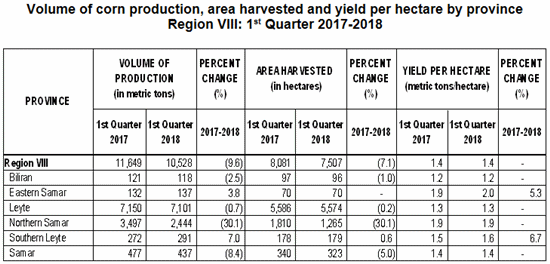
1st quarter palay
production in Eastern Visayas declines by 2.1%
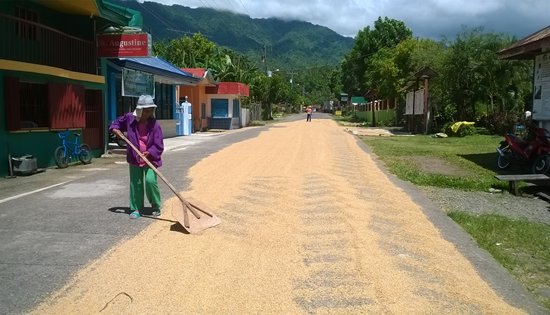
By
PSA-8
May 23, 2018
TACLOBAN CITY –
Palay production in Eastern Visayas declined by 2.1% from 285,616
metric tons (MT) in the first quarter of 2017 to 279,728 MT in the
first quarter of 2018. Decreases were observed among all provinces,
except in Northern Samar and Southern Leyte, which posted an
increase of 12.1% and 4.8%, respectively.
Among the provinces, Leyte
produced the highest volume of palay at 147,131 MT, which comprised
more than half (52.6%) of the total palay production in the region.
Biliran, meanwhile, had the lowest volume of production (1,938 MT)
accounting for only 0.7%.
The total harvest area for
palay in the region likewise decreased by 0.3%, from 89,139 hectares
in the first quarter of 2017 to 88,865 hectares in the first quarter
of 2018. Biliran contributed largely to this decrease posting a drop
of 83.9%.
Leyte recorded almost
two-fifths or 38.8% (34,498 hectares) of the total palay area
harvested during the quarter in review, while Biliran contributed
the least (429 hectares) accounting for only 0.5%.
Yield per hectare for
palay in the region went down by 3.1%, from 3.2 MT per hectare in
the first quarter of 2017 to 3.1 MT per hectare in the same quarter
of 2018.
Among the provinces,
Biliran and Southern Leyte posted the highest yield per hectare
during the quarter in review at 4.5 MT per hectare. Eastern Samar
registered the lowest yield per hectare at 2.1 MT per hectare.
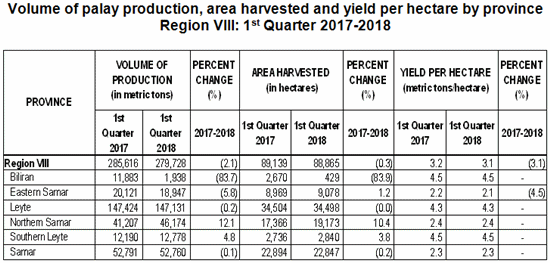
Karapatan submits
report on HR violations during 1-year of martial law in Mindanao to
local officials, UN experts
By
KARAPATAN
May 22, 2018
QUEZON CITY – In
letters to at least seven UN independent experts and special
procedures, to Commission on Human Rights Chairperson Jose Luis
Martin Gascon and to Sec. Silvestre Bello III, in his capacity as
Chairperson of the Negotiating Panel in the Government of the
Republic of the Philippines Peace Negotiations with the National
Democratic Front of the Philippines, Karapatan submitted a report on
the civil and political rights violations during the one-year
implementation of martial law in Mindanao under the administration
of Pres. Rodrigo Duterte.
“The report outlines how
the Duterte administration, through his own brand of war-on-terror
with the imposition and extension of martial law in Mindanao and the
continuing implementation of government’s counterinsurgency program
Oplan Kapayapaan, has promoted State terrorism and violence in the
Southern Philippines,” said Karapatan Secretary General Cristina
Palabay.
Since the declaration of
martial law on May 23, 2017, Karapatan documented at least 49
victims of extrajudicial killings in Mindanao, with an average of
one victim killed every week. Most of the victims are indigenous
peoples and members of local peasant organizations targeted for
their local campaigns for genuine agrarian reform and against
militarization.
Karapatan also documented
22 cases of torture, 116 victims of frustrated extrajudicial
killings, 89 victims of illegal arrest and detention, and 336,124
victims of indiscriminate gunfire and aerial bombings. At least 404,
654 individuals have been displaced, largely because of these
bombings. “Many more reported cases reveal a much graver magnitude
of the effects of martial law. The dangers of ensuring security in
traveling across the area prevent news gatherers and documenters
from looking into field conditions so as to fully report on the
human rights situation,” Palabay stated.
Karapatan called on the
officials and UN experts to conduct an independent investigation on
the rights violations during the imposition of martial law in
Mindanao, the immediate lifting of martial law in Mindanao which has
been used by Philippine State security forces as license to further
perpetuate rights violations, the immediate investigation and
prosecution of perpetrators which include the Armed Forces of the
Philippines (AFP), and elements of the police; and an end to
counter-insurgency programs like Oplan Kapayapaan which encourage
the use of ‘hit lists’ that target activists and civilians.
The human rights
organization also reminded the Philippine Government to pursue its
commitments under the Comprehensive Agreement on the Respect of
Human Rights and International Humanitarian Law (CARHRIHL), and to
adhere and respect the Universal Declaration of Human Rights and all
major human rights instruments that is a party and signatory.
Download the Report here.